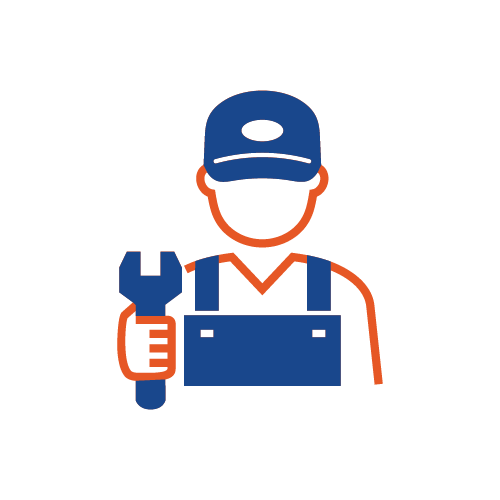FAQS
What Does HVAC Stand For?
H: Heating V: Ventilation AC: Air Conditioning
How to Replace an Air Conditioning Filter?
Replacing your air conditioning filter regularly will not only improve the efficiency of your air conditioner but may prolong its life. When you do not replace your air conditioning filter, dirt, dust and grime block the flow of air, forcing it to bypass the filter and putting the dirt directly into the evaporator coil. The evaporator coil is the part of your air conditioner that absorbs heat, keep the coil clean to prevent your compressor and fans from failing. Replacing your air conditioning filter is not as intimidating as it sounds just follow these tips below:
- Location. Your air conditioning filter is located somewhere along the ductwork that returns air from the building and to the air conditioner. Filters can also be located in the air conditioner itself, in ceilings, walls or furnaces.
- System. There are a few different kinds of filtration methods that can be used. One of the less expensive filters uses strands of fiberglass or folded pleats. These are usually disposable and can be found at the local home improvement store or even the grocery store. There are also electrostatic charged filters that are either washable or disposable. Sometimes these filters have to be specially ordered to fit the filtration equipment. The washable filters may cost more to begin with but since they are reusable they can save money over time as well as having a lower impact on the environment. If you cannot identify the filter by sight, you can always bring it with you to the store.
- Frequency. If you do have a disposable filter you should check your air conditioning filter every month. In most cases you will end up changing it more often during months where the system is running more frequently, such as the summer. Having pets, being a smoker, living on a dirt road can also affect how often you should change your filter.
- Size. When purchasing the replacement filter, be sure to measure the existing filter. A good idea is to keep the actual box the filters came in. Storing extra filters in the box will also protect them from getting dirty or damaged before use. If you do not have the box you can simply use a tape measure to find the correct size of the filter you need.
- Efficiency. Don’t be fooled into thinking that replacing your filters less frequently can save you money. Though air conditioning filters can be expensive, the efficiency of your air conditioner is greatly increased when the filters are frequently changed. You do not want dirt building up inside your system. As little as an 1/8” of dirt on your coil can affect your systems efficiency by up to 20%. No matter what type of filter you use, make be sure to check it often and to replace it when it starts looking fuzzy.
Not Sure if You Need HVAC Repairs? Try Our Checklist!
HVAC repair tops the list of things that you do not want to have disrupt your day and repairs can be expensive. A broken HVAC system is something you cannot ignore and it’s critical to your family’s comfort. We are always happy to serve you but we would like you to avoid unnecessary repair bills. Below is a list of common HVAC problems that can sometimes be fixed without a service call.
- Check your air filter. If it hasn’t been replaced in a while, or especially if it looks dirty, swap out the old filter for a new one and allow your system to run for a couple of hours. If nothing improves, go ahead and give us a call.
- Check circuit breakers and switches. This might seem like a no-brainer, but sometimes power switches and breakers can be turned off by accident. However, keep in mind that a tripped HVAC breaker might be an indication of a larger problem.
- Check the switch on the indoor and the outdoor unit.There should be an on-off switch next to the indoor air handler and the outdoor unit for safety reasons. Be careful flipping the switch to the outside, as this switch controls the 240 volts of electricity to the outdoor A/C unit and it’s very dangerous.
- Check vents, grills, and air registers for blockage. Furniture that has been moved in front of air registers can create problems for the HVAC system. Make sure nothing is blocking vents or grills, and that sufficient flow is possible.
- Check for water in the drain pan under the indoor unit. Many A/C units have a safety switch to stop them from operating if water could leak into your home and damage ceilings and floors. Checking for water in a pan under the unit could tell you the drain is clogged. Simply empty the pan and clean out the drain line.
- Make sure there is fuel in the tank. This applies to oil and propane heating systems in the winter time. If the tanks have been run dry, first call the oil or propane supplier, but know that you will need to give us a call to bleed the lines due to issues from running the tank dry.
- Contact your landlord or property manager FIRST. If you are renting your property, the landlord, owner, or property manager needs to be contacted first, before service technicians. At Advance Mechanical Heating and Cooling, we won’t work on a system without owner approval.
If after completing our checklist you still need a repair please give us a call immediately at (252) 355-9191
How to Use a Programmable Thermostat
Having and correctly using a programmable thermostat is an easy way to save energy (and therefore money). By adjusting your thermostat by a few degrees for several hours at a stretch (at night while you sleep or while you’re at work), you can reduce your heating bill substantially (by about 10% per year). Here are some pointers to help you understand how to use your programmable thermostat.
- Programmable Thermostat Model. Choose the model that’s right for your schedule:
- 7-day models are the best for those who have a schedule that changes daily. This option allows you to have a different program for each day of the week. This model will require a lot of programming since it may require you to set a different schedule for each day, even if the schedule for some of your days are the same.
- 5 + 2 day models use the same schedule for five days in a row (presumably the weekdays) and then another schedule for two days (presumably the weekend). This model is ideal for those who have a regular work schedule for 5 days in a row and then a different schedule for the 2 days off.
- 5-1-1 day models use the same schedule for five days in a row and then a different schedule for each day of the weekend. This model would be ideal for those who have a completely different schedule on Saturday than on Sunday. An example would be someone who spends most of one part of Saturday outside the home (at least 6 hours) at the same part of the day every Saturday and then spends most of the day home on Sunday. Another example would be someone who travels most weekends. So they would leave on Friday and come back on Sunday. They would not need their system to keep the temperature at a comfortable level all weekend, they just need it to come on Sunday so that it will be correct when they arrive home.
- Programmable Thermostat Placement. All thermostats, no matter the type, should be located in a central location away from draft, doors, lamps, windows, skylights, and direct sun. You want the temperature that the thermostat is reading to be accurate and not affected by other sources.
- Programmable Thermostat Use. The majority of programmable thermostats have four programmable periods of the day (time for waking up, leaving for work, returning home, and sleeping), and you get to choose what you would like the temperature to be during each of those periods. Consider what time you go to work and bed, you should have the thermostat begin to adjust temperature 30 minutes to an hour before this occurs. For waking up and going to work you should have the thermostat start adjusting the temperature back up to your comfort level about an hour before waking up or leaving for work. and perhaps begin cooling the house down as bedtime approaches. Remember that the goal is to have an eight-hour period during which the system is not working as hard.
- Programmable Thermostat Features: A key to using your programmable thermostat well is to understand its features:
- Manual Override You can manually override your settings at any time by using the manual override feature. The manual override will revert back to the programmed setting within a period of time that was programmed as part of the thermostat set up or when the next program begins.
- Vacation Override This override allows you to temporarily override the settings programmed into your thermostat. This allows you to adjust the temperature while you are away, saving energy and money.
- Keyboard Lock This allows you to lock the thermostat so that others cannot adjust the program or settings. This is ideal in a business, rental property, or a home where the kids are prone to try to adjust.
- Battery Indicator There is a small battery in your thermostat that holds your programming. Most thermostats have an indicator light to let you know when the batter is getting low.
- Filter Change Indicator This reminder can be programmed by you or skipped. It is a good idea to have a reminder of some kind to let you know to check the filters. Remember that changing your filters when they are dirty will improve the efficiency of the HVAC system.
- Auto Season Changeover This feature changes your settings with the seasons and day light savings time.
Good luck with your programmable thermostat. Please make sure that the programmable thermostat that you purchase will be compatible with your system. If you are unsure or uncomfortable purchasing one yourself you can purchase through Advance Mechanical and we will install and program the thermostat for you. We also offer thermostats with Wi-Fi so that you can monitor your system through your smart phone from anywhere.
Repair or Replace?
As a general rule, if your unit is less than 5 years old, it’s probably better to repair it. If it’s over 8 years old and the repairs are major, consider replacing it. If it’s somewhere in between, it depends on your warranty and the price of the failing parts. If you have an older unit with a SEER rating of less than 8, the increased efficiency of a new one can reduce your monthly power bill. According to the Department of Energy, each increase of 1 point on the SEER rating results in an approximate 10% increase in efficiency. Look for the ENERGY STAR® label for central air conditioners with SEER ratings of 13 or greater.
Should I Replace all of my HVAC Equipment at the Same Time?
Yes. You want to be sure that all the parts of your HVAC system work together properly. Replacing only the outdoor unit or the indoor unit of an HVAC system may appear to save money, but it could contribute to service problems later on. By replacing all parts you make sure that the system is performing at maximum efficiency. This also includes the ductwork. Ductwork that is leaky, blocked, inadequate or not sized to the new system will affect the efficiency of your system. Ask your contractor to thoroughly inspect your ductwork to identify any problems and have them addressed as part of the installation. At Advance Mechanical we design and fabricate all ductwork in house. This allows us to custom design ductwork to meet your home’s unique needs.
What Size System do I Need?
You want to make sure that your new HVAC system is accurately sized to meet your home’s comfort needs. An HVAC system that is too small cannot deliver adequate heating or cooling in extreme weather; a system that is too large will not only cost more, but provide poorer temperature control. To ensure that your new HVAC system is the right size for your home make sure that the contract performs a detailed load calculation. A detailed load calculation determines the capacity of the equipment needed as well as the correct distribution of air to each room.
What does my House Have to do with it?
The size of the HVAC system that you need will be greatly affected by the energy usage of your home. Before you decide on an HVAC unit, look at making energy improvements to your home. Addressing areas of energy waste in your home not only reduces operating costs of the system but can mean a smaller, less expensive HVAC system can do the job.
What is SEER?
SEER stands for Seasonal Energy Efficiency Ratio and designates the efficiency rating of air conditioning systems. A 14 SEER air conditioner is more efficient than a 10 SEER unit. As of January 2006, manufacturers are no longer permitted to manufacture air conditioning systems with a SEER less than 13. Prior to this date, the minimum SEER was 10. According to the Department of Energy, each increase of 1 point on the SEER rating results in an approximate 10% increase in efficiency. Look for the ENERGY STAR® label for central air conditioners with SEER ratings of 13 or greater.
How to Maximize the Benefits of Your Thermostat
Everyone knows that your central heating and air conditioning system consumes as much as 50% of your monthly energy, but did you know that you can actually save money each month on your utility bill when you install an energy efficient programmable thermostat to control your heating and air conditioning system? Here’s how to get the most bang for your buck with your energy efficient programmable thermostat according to Consumer Reports:
How Thermostats Work
Thermostats use sensors to monitor your home’s temperature and regulate heating and cooling equipment in accordance with the temperatures you specify. Older thermostats require manual adjustment of the temperature, but programmable thermostats have microprocessors that allow you to program your home temperatures to better fit your lifestyle. Now your thermostat can keep your house at the perfect comfort level while you’re home, and automatically dial up or down the temperatures to conserve energy when you’re sleeping or away. Program it once to set the desired times and temperatures, and you’ll save on your energy bills all season long. When running your air conditioning system, set the thermostat to 78°. Keeping your house at 78° instead of 72° can save you 39% on your cooling costs. When you will not be home for at least 6 hours set the system to switch to a higher temperature to save even more. Of course, if you have pets, you must preserve a stable, comfortable temperature for their wellbeing, so don’t go hog-wild. Never turn your air conditioning off completely, even if you are leaving for several days. When the system is turned off it can lead to mold, moisture, and humidity problems. When it’s cold outside, and your furnace is doing the heavy lifting, set your thermostat to around 68° degrees, or lower if you can stand it. Each degree below 70° saves you roughly 3% on your annual heating bill. For those periods when you’re absent, set it to switch to 60° or so, and then revert to its normal setting when you come home. Again, don’t get carried away, as turning it off entirely may cause your pipes to burst if temperatures drop far enough. NOTE: When you return after an absence, you might be tempted to crank the heat up in an attempt to heat the house quickly, but that can erase any savings you’ve accrued so far.
Swiss Army Thermostat
The feature list of modern thermostats is a long one, with scads of fancy doodads to do everything but tuck you in at night. Here are some of the most notable bells and whistles:
- Seven-day programming, permitting a different schedule for each day of the week, or any combination of days you want.
- A vacation override, which lets you temporarily alter the programmed settings.
- A keyboard lock, which prevents unauthorized changes to your settings, to the consternation of uppity teenagers and presumptuous babysitters everywhere.
- A low-battery indicator that warns you when the battery used to store the programmed schedule weakens.
- An automatic season changeover that switches between heating and cooling at the onset of different seasons.
Relax & Enjoy
Of course, another big plus of a programmable thermostat is that you have one less thing to think about around the house. When properly set to mirror your schedule, it’ll seem like your home is responding to your presence, and providing you with heat and warmth without you having to lift a finger. Now if you could only automate it to do the dishes… To order your energy efficient wireless programmable thermostat with above features call Advance Mechanical now 252-355-9191
Summer Maintenance Checklist
Whether your typical summer weather is hot, mild, dry, stormy, or humid, follow these steps to make sure both you and your home survive the heat.
Inside the Home
You might spend a lot of time indoors to keep cool this summer. Make sure everything is in working order.
- Inspect ceiling fans and make sure blades are in balance and clear of dust
- Repair stuck or sticking windows
- Apply spray lubricant or silicone to window tracks
- Service the air conditioner or evaporative cooler
- Change the air conditioner filter
- Have chimneys cleaned
- Check smoke and carbon monoxide detectors, replace the batteries
- Spray for insects in gaps around ducts and outlets
- Close the chimney damper
- Make sure houseplants have an adequate supply of water
- Have your hot water heater checked
- Lubricate locks, hinges, and latches
- Test your alarm system
- Have your dehumidifier checked
In the Garage
During the summer, your garage may be the hottest place in the house. Prepare it for the temperature change.
- Lubricate rolls and guides on your garage door
- Properly ventilate the garage
- Make sure the things stored there can take the heat
Winter Maintenance Checklist
Your HVAC system works overtime during the winter. Follow these tips to keep your system in top shape and running smoothly all season long.
- Clean and replace air filters
- Clean vents and ducts
- Inspect home for energy leaks. Seal any leaks around doors, windows or other openings – especially in the basement, attack and crawlspace.
- Make sure your thermostat is working properly
- Replace batteries in carbon monoxide detector and test
- After you turn on your heat, listen to your HVAC unit for abnormal noises or banging. Contact a HVAC professional if you hear anything strange.
- Have your dehumidifier checked
- Have your HVAC system inspected by a professional
Check out our blog for more HVAC Winter Maintenance Tips to stay warm and cozy all winter long!
What are Your Service Areas?
We service Pitt, Beaufort, and Lenoir counties including the towns of Greenville, Washington, Winterville, Bath, Farmville, Ayden, Grifton, Bethel, Grimesland, Kinston, La Grange, Deep Run, and Pink Hill.
What to Know Before You Make a Decision
Selecting a trustworthy and professional contractor
- Ask about the licensing and qualifications of prospective contractors. Is the contractor state-licensed? Is the contractor a member of state and national contractor associations, such as Air Conditioning Contractors of America (ACCA)? Is the contractor adequately insured?
- Make sure that the contractor inspects your home and your existing system, and explains your options.
- Ask the contractor for the estimated annual operating cost of HVAC systems with different efficiencies (SEERs and HSPFs). This information will help you determine the total cost of each system over the lifetime of the unit.
- Make sure the contractor has adequate staff to install the system and respond promptly to service calls.
- What guarantees, warranties and follow-up service are offered? Warranties vary, so it’s important to know what is included in the warranty and what is not. Ask about a maintenance service agreement—what does it cost and what does it cover?
- Are the technicians familiar with the brand of equipment that you want to buy? Will they perform load calculations, duct design and installation using industry-standard methods?
- Get three written estimates for the work: what is being done, what equipment is being provided and when installation will begin and be completed. Understand what is included in each price. Remember that the best value may not necessarily come from the contractor that offers the lowest price. Consider the cost of operating the system as well as the initial cost.
What’s the Difference between Split System and Packaged Air Conditioners?
If you’re shopping around for a new central air conditioner for your home, you’ve probably seen that there are two main types:
- Split systems
- Packaged systems
But do you know which one your home has or why? In this blog you’ll learn:
- The differences between these two systems
- The pros and cons of each
- How to know which one fits your home’s needs
Split Air Conditioning System
What it is: In a split-system central air conditioner there are two parts an outdoor metal cabinet and an indoor cabinet. That’s why it’s called a “split” system. The outdoor cabinet contains the condenser and compressor and typically sits on a concrete slab outside your home. The indoor cabinet contains the evaporator and is usually located in the attic or a closet. The indoor cabinet also typically includes a furnace (or the inside part of a heat pump). The indoor and outdoor units are connected by a refrigerant line.
What is a Split Air Conditioner System?
A split air conditioner consists of two main parts: the outdoor unit and the indoor unit. The outdoor unit is installed on or near the wall outside of the room or space that you wish to cool. The unit houses the compressor, condenser coil and the expansion coil or capillary tubing. The sleek-looking indoor unit contains the cooling coil, a long blower and an air filter.
How is a Split Air Conditioner Different from Other A/C Units?
A split air conditioner does not require major installation work because it does not require ductwork. Rather, the indoor and outdoor units are connected with a set of electrical wires and tubing. This is good for your wallet and the environment. The ductwork required for many traditional A/C units generally increases energy expenditures, as many centralized A/C units lose a lot of energy due to heat exchange in the air duct system. So, without a duct system, there is very little opportunity for heat or energy loss in a split air conditioner system.
Benefits of a Split Air Conditioning System
This kind of air conditioner system has many advantages over traditional air conditioners. Perhaps the most obvious benefit is the quiet performance of a split air conditioner system. The parts of an air conditioner that make the most noise are the compressor and the fan that cools the condenser. In a split system, the compressor and fan for the condenser are located outside of the room being cooled and therefore the major sources of noise are removed – unlike with window units. Another benefit of a split air conditioner system is that you can opt for a multi-split system, where you can have more than one indoor unit connected to a single outdoor unit. This makes it easy to cool multiple rooms or maintain the temperature throughout a large room through the use of two indoor cooling units. A split air conditioner is an efficient and cost-effective way to cool your home. It should be noted that the initial cost of this kind of air conditioning unit is significantly higher than a window unit and it does require professional installation. However, the amount of money you will save on your energy bills as well as the longevity of the unit will make it worth your while in the end. Here’s a simple diagram of a split system: Pros:
- Greater energy efficiency possibilities – Split air conditioning systems have SEER ratings from 13 to 23.
Cons:
- Labor costs – Labor costs more because you are installing a unit outside the house and also inside (usually in the attic or crawlspace, depending on the type of air handler). Also, the system can’t be charged with refrigerant until it has been set in place, which adds to the cost.
When you’d want this: It’s a more cost efficient choice if your home already has a furnace, and you are purchasing a new air conditioning unit or replacing an older unit. Learn more about this on Energy.gov’s website.
Packaged air conditioning system
What it is: The evaporator, condenser, and compressor are all located in one cabinet and thus “packaged” together. This single cabinet is usually placed on a roof. Some packaged air conditioners can include electric heating coils or a natural gas furnace. That means you won’t need a separate furnace inside. Pros:
- Space efficiency – Unlike split-system units, the package unit has all the components in one place.
- Cheaper installation – Since packaged units can come pre-charged with refrigerant, and they are only installed outside, installation is cheaper than a split unit.
Cons:
- Limited energy efficiency: Packaged units typically have a SEER rating from 10 to 18.
When you’d want this: A packaged system is ideal for situations where indoor space is limited and therefore important. This is usually the case for mobile homes and homes with a crawl space. The final word The biggest factor to consider is the construction of your home. Most newer homes were built with split central air conditioning because it’s much more cost-efficient to run over time. However, if you live in an older or smaller home or a mobile home, you probably have a packaged unit because of space restrictions.
Choose and Upgrading Your Central Air Conditioner
Central air conditioners are more efficient than room air conditioners. In addition, they are out of the way, quiet, and convenient to operate. To save energy and money, you should try to buy an energy-efficient air conditioner and reduce your central air conditioner’s energy use. In an average air-conditioned home, air conditioning consumes more than 2,000 kilowatt-hours of electricity per year, causing power plants to emit about 3,500 pounds of carbon dioxide and 31 pounds of sulfur dioxide. If you are considering adding central air conditioning to your home, the deciding factor may be the need for ductwork.
If you have an older central air conditioner, you might choose to replace the outdoor compressor with a modern, high-efficiency unit. If you do so, consult a local heating and cooling contractor to assure that the new compressor is properly matched to the indoor unit. However, considering recent changes in refrigerants and air conditioning designs, it might be wiser to replace the entire system. Today’s best air conditioners use 30% to 50% less energy to produce the same amount of cooling as air conditioners made in the mid-1970s. Even if your air conditioner is only 10 years old, you may save 20% to 40% of your cooling energy costs by replacing it with a newer, more efficient model.
Proper sizing and installation are key elements in determining air conditioner efficiency. Too large a unit will not adequately remove humidity. Too small a unit will not be able to attain a comfortable temperature on the hottest days. Improper unit location, lack of insulation, and improper duct installation can greatly diminish efficiency. When buying an air conditioner, look for a model with a high efficiency.
Central air conditioners are rated according to their seasonal energy efficiency ratio (SEER). SEER indicates the relative amount of energy needed to provide a specific cooling output. Many older systems have SEER ratings of 6 or less. When purchasing a central air conditioner, look for the ENERGY STAR® label. New residential central air conditioner standards went into effect on January 1, 2015; see the efficiency standards for central air conditioners for details, and consider purchasing a system with a higher SEER than the minimum for greater savings.
The standards do not require you to change your existing central air conditioning units, and replacement parts and services should still be available for your home’s systems. The “lifespan” of a central air conditioner is about 15 to 20 years. Manufacturers typically continue to support existing equipment by making replacement parts available and honoring maintenance contracts after the new standard goes into effect. Other features to look for when buying an air conditioner include:
- A thermal expansion valve and a high-temperature rating (EER) greater than 11.6, for high-efficiency operation when the weather is at its hottest
- A variable speed air handler for new ventilation systems
- A unit that operates quietly
- A fan-only switch, so you can use the unit for nighttime ventilation to substantially reduce air-conditioning costs
- A filter check light to remind you to check the filter after a predetermined number of operating hours
- An automatic-delay fan switch to turn off the fan a few minutes after the compressor turns off.
Installation and Location of Air Conditioners
If your air conditioner is installed correctly, or if major installation problems are found and fixed, it will perform efficiently for years with only minor routine maintenance. However, many air conditioners are not installed correctly. As an unfortunate result, modern energy-efficient air conditioners can perform almost as poorly as older inefficient models. When installing a new central air conditioning system, be sure that your contractor:
- Allows adequate indoor space for the installation, maintenance, and repair of the new system, and installs an access door in the furnace or duct to provide a way to clean the evaporator coil
- Uses a duct-sizing methodology such as the Air Conditioning Contractors of America (ACCA) Manual D
- Ensures there are enough supply registers to deliver cool air and enough return air registers to carry warm house air back to the air conditioner
- Installs duct work within the conditioned space, not in the attic, wherever possible
- Seals all ducts with duct mastic and heavily insulates attic ducts
- Locates the condensing unit where its noise will not keep you or your neighbors awake at night, if possible
- Locates the condensing unit where no nearby objects will block airflow to it
- Verifies that the newly installed air conditioner has the exact refrigerant charge and airflow rate specified by the manufacturer
- Locates the thermostat away from heat sources, such as windows or supply registers.
If you are replacing an older or failed split system, be sure that the evaporator coil is replaced with a new one that exactly matches the condenser coil in the new condensing unit. (The air conditioner’s efficiency will likely not improve if the existing evaporator coil is left in place; in fact, the old coil could cause the new compressor to fail prematurely.)



 (252) 355-9191
(252) 355-9191




